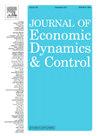Dynamic labor demand and informality
IF 2.3
3区 经济学
Q2 ECONOMICS
引用次数: 0
Abstract
Formal firms across the size distribution face static and dynamic incentives to employ informal labor. In this paper, I explore the implications of these incentives for resource allocation within and across firms and for policies that address informality. I build and estimate a structural model in which firms employ informal labor to evade payroll taxes (a static incentive) and to avoid the adjustment costs incurred when hiring or firing formal workers (a dynamic incentive). Formal firms do not report informal labor in official data. I overcome this obstacle with a novel strategy that exploits a 2015 shock to the enforcement of Albanian tax laws to extract information about firms' use of informal labor which I use to estimate the model. I reach three conclusions. First, I show that the gains in allocative efficiency that accrue to better enforcement of labor laws are far more modest after accounting for firms' dynamic incentives to use informal labor to adjust to shocks. Second, failing to account for informal labor results in an overstatement of formal labor adjustment costs by a factor of two. Intuitively, firms use informal labor to avoid the cost of varying output, and thus the reported data understates variation in their actual use of labor. Third, I show that reducing the costs of rigidities in formal labor markets is as effective as enhanced enforcement in reducing the aggregate informal share of employment.
动态劳动力需求与非正式性
在整个规模分布中,正规企业都面临着雇佣非正规劳动力的静态和动态激励。在本文中,我探讨了这些激励对企业内部和企业之间资源配置的影响,以及对解决非正式性的政策的影响。我建立并估计了一个结构模型,在这个模型中,企业雇佣非正式劳动力来逃避工资税(静态激励),并避免雇佣或解雇正式工人时产生的调整成本(动态激励)。正规企业在官方数据中不报告非正规劳动力。我用一种新颖的策略克服了这一障碍,该策略利用2015年对阿尔巴尼亚税法执行的冲击来提取有关企业使用非正式劳动力的信息,我用这些信息来估计模型。我得出了三个结论。首先,我表明,在考虑到企业使用非正式劳动力以适应冲击的动态激励后,更好地执行劳动法所产生的配置效率的收益要小得多。其次,不考虑非正式劳动力导致正式劳动力调整成本被夸大了两倍。直观地说,企业使用非正式劳动力以避免变动产出的成本,因此报告的数据低估了他们实际使用劳动力的变化。第三,我证明降低正规劳动力市场僵化的成本与加强执法在减少非正规就业的总份额方面同样有效。
本文章由计算机程序翻译,如有差异,请以英文原文为准。
求助全文
约1分钟内获得全文
求助全文
来源期刊

Journal of Economic Dynamics & Control
ECONOMICS-
CiteScore
3.10
自引率
10.50%
发文量
199
期刊介绍:
The journal provides an outlet for publication of research concerning all theoretical and empirical aspects of economic dynamics and control as well as the development and use of computational methods in economics and finance. Contributions regarding computational methods may include, but are not restricted to, artificial intelligence, databases, decision support systems, genetic algorithms, modelling languages, neural networks, numerical algorithms for optimization, control and equilibria, parallel computing and qualitative reasoning.
 求助内容:
求助内容: 应助结果提醒方式:
应助结果提醒方式:


